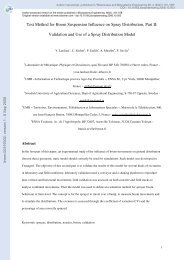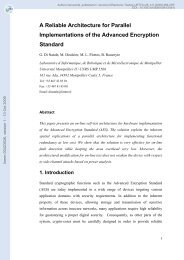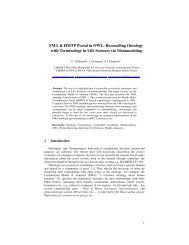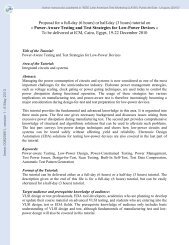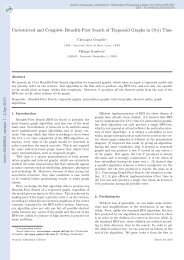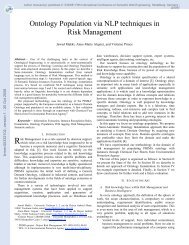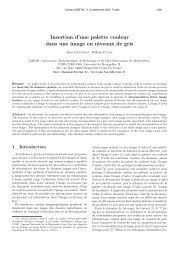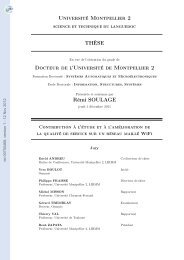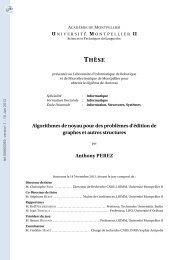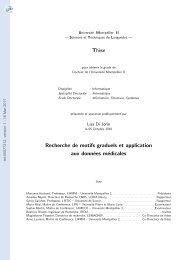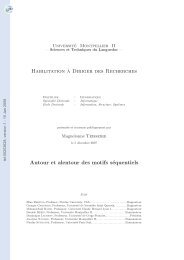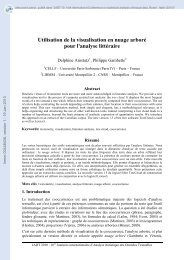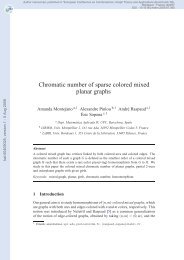A guaranteed obstacle avoidance guidance system: The safe ...
A guaranteed obstacle avoidance guidance system: The safe ...
A guaranteed obstacle avoidance guidance system: The safe ...
You also want an ePaper? Increase the reach of your titles
YUMPU automatically turns print PDFs into web optimized ePapers that Google loves.
hal-00733826, version 1 - 19 Sep 2012<br />
Auton Robot (2012) 32:177–187 183<br />
<strong>The</strong>n, if σOA = 1, TOA exists, and ψOA is chosen as one of<br />
the two directions of the tangent of SOA on TOA. <strong>The</strong> direction<br />
of −−−−→<br />
PRCOA is computed as ψRCOA := atan2((yOA − y),<br />
(xOA − x)), where atan2() is the four quadrants arctangent<br />
computation function. <strong>The</strong> ψOA direction is chosen according<br />
to<br />
ψOA := ψRCOA + π/2, if [ΣOA = 1],<br />
ψOA := ψRCOA − π/2, if [ΣOA<br />
(14)<br />
= 2].<br />
This particular choice induces an interesting behavior.<br />
When the first detection is made on portboard (<strong>obstacle</strong> on<br />
the left side, ΣOA = 1), the choice ψOA = ψ + π/2 the<br />
RCOA<br />
<strong>system</strong> is contouring the <strong>obstacle</strong> by the right, and keep this<br />
strategy as fas as σOA = 1. Similar strategy occurs when the<br />
initial detection is made on starboard. This is allowing for<br />
avoiding the known trap situation, called corner situation in<br />
Lapierre et al. (2007), where <strong>obstacle</strong>s are present on both<br />
sides. This computation of ψOA induces a U-turn in such a<br />
situation. This implies that the ability of the vehicles to enter<br />
and maneuver into a narrow corridor, for example, depends<br />
on the size of the SMZ, i.e. rS.<br />
Moreover, an unbounded definition of the angles involved<br />
in the computation of the second condition of (12),<br />
i.e. {ψ,ψPF,ψOA} ∈[−∞, +∞], induces another interesting<br />
behavior. Since the vehicles are ‘keeping the contact’<br />
with <strong>obstacle</strong>s on the same side (portboard/starboard), they<br />
naturally find an issue from the entrance to the exit of a 2D<br />
maze, if the solution exists and, consecutively, contour the<br />
<strong>obstacle</strong>s to converge again to the path, when σOA = 0. As a<br />
consequence a solution exists if there is a continuous region,<br />
free of <strong>obstacle</strong>, with a minimum width of 2rS.<br />
Finally, the control is achieved in considering TOA and<br />
1/rS instead of TPF and c, within the control expression<br />
(11).<br />
Now an interesting question arises: what performances<br />
are expected from this <strong>obstacle</strong> <strong>avoidance</strong> strategy? In the<br />
following, we propose a method to chose the size of the<br />
SMZ, rs, such that the induced maneuver is <strong>guaranteed</strong> to<br />
be performed within a global amplitude less than rs.<br />
3.3.2 Choice of rs<br />
<strong>The</strong> aim of the following propositions is to find a method to<br />
choose the control gains and rs, in order to guarantee that<br />
the <strong>avoidance</strong> is <strong>safe</strong>ly performed. This is achieved using a<br />
set of conditions, exposed in the following statements. <strong>The</strong><br />
objective is to find a feasible solution. Optimization comes<br />
after.<br />
Some preliminary remarks have to be exposed. Once the<br />
<strong>obstacle</strong> <strong>avoidance</strong> strategy is engaged, the robot converges<br />
to TOA, which lives on the SMZ boundary, i.e. a circle of<br />
radius rs. By construction COA, PR and TOA are aligned.<br />
We conclude that s1 = 0 and y1 =COAPR. Let denote the<br />
initial instant when the <strong>obstacle</strong> <strong>avoidance</strong> is engaged as t 0 OA ,<br />
then y1(t0 OA ) = 0, and let ˜θ 0 = θ(t0 OA ) − δ(t0 OA ) denotes the<br />
initial angle of incidence of the robot with respect to the<br />
SMZ tangent.<br />
Proposition 2 <strong>The</strong> controller exposed in (8) induces trajectories<br />
that remain within the maneuvers induced by the unsaturated<br />
version of the path following controller (5). That<br />
is, given a <strong>system</strong> situation (y1,s1,θ), the resulting saturated<br />
control computation (8) induces a trajectory with a<br />
higher curvature than with (5), i.e.:<br />
<br />
<br />
<br />
r <br />
PF <br />
><br />
<br />
rPF<br />
<br />
<br />
, ∀t >t0 OA . (15)<br />
u PF<br />
ud<br />
In other words, the use of (8) does not drive the <strong>system</strong><br />
closer to the <strong>obstacle</strong>, than using (5). <strong>The</strong> rationale of this argument<br />
is to exploit the GEC property of (5), which induces<br />
maneuvers that bound the trajectories induced with (8).<br />
Hence, proving that y1(t) < rs − BS, ∀t >t0 OA , where BS<br />
plays the role of a security margin, with (5) is enough to<br />
prove that the <strong>system</strong> remains at a minimum distance of BS<br />
from <strong>obstacle</strong>, using (8).<br />
Proof <strong>The</strong> idea is to find the condition on the choice of the<br />
control gains, K2 and k3, such that the curvature of the trajectories<br />
induced by (5) is always smaller than the one obtained<br />
with (8). This is expressed by condition (15).<br />
Using the expression of (5) and (8), and their respective<br />
developments, we can equivalently rewrite Condition (15)<br />
as:<br />
a.b.k3tanh (|θ − δ|)>K2(|θ − δ|) (16)<br />
where a = 1+ 1 4 +Lf 2<br />
r<br />
1+ 1 4<br />
and b = Rwmax− L 4<br />
Rwmax− L 4 −Lg2 , which under<br />
r<br />
the conditions (10) are both bigger than 1. When <strong>obstacle</strong><br />
<strong>avoidance</strong> is engaged, the maximum value achieved by θ −δ<br />
is π/2, hence (16) is true if:<br />
<br />
π 2 <br />
k3 >K2 1 + . (17)<br />
4<br />
<br />
Conditions (10) have also to be considered, which with<br />
<strong>obstacle</strong> <strong>avoidance</strong> particularity (s1 = 0) can be expressed<br />
as k3 < R L wmax. <strong>The</strong>n global condition on the gain k3, expressed<br />
as:<br />
R<br />
L wmax<br />
<br />
π 2 <br />
>k3 >K2 1 + , (18)<br />
4<br />
restricts the range of admissible values for k3.<br />
Since the previous argument, we can now use the exponential<br />
convergence property of the <strong>guidance</strong> error (θ − δ),<br />
induced by the control (5),<br />
( ˙θ − ˙δ) =−K2(θ − δ) ⇒<br />
θ(t)= ˜θ0e −K2t<br />
(19)<br />
+ δ(t), ∀t >t0 OA .



